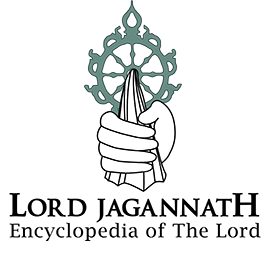Royalty in the service of Lord Jagannath
Nowhere else but in Puri, started the unique tradition of a king himself sweeping the chariots of the deities. Every year during Rath Yatra thousands of people gather in Puri to witness it before they pull the chariots. Among all other sevas the king does, this seva named Chera Pahara [sweeping of the chariots] has been the most important seva done in front of millions watching it.
As mentioned in the Swatwalipi, [record of rights] once the three deities are installed on the three chariots, both before Sri Gundicha Yatra and Bahuda Yatra, the next ritual Chera Pahara is to be performed by the Gajapati [king] himself who arrives at the place with his entourage. It’s an ancient practice to perform a ritual similar to Chera Pahara, on the Snana Vedi during Deva-Snana Purnima, on the Dola Vedi during Dola Purnima and on the Chapa [swan shaped boat] during the first and last days of Chandan Yatra. The practice of such a ritual was perhaps conceived to inculcate in the minds of the devotees that God has created us equal and does not discriminate between a king and a sweeper.
In addition to this most popular seva there are some other sevas of Lord Jagannath, performed by the Gajapati both in and out of the temple. Here is a list of some of the sevas with a short explanation on them.
Gajapati takes an important role in Lakshmi Narayana Bheta [reuniting Goddess Lakshmi and Lord Jagannath] during the Bahuda Yatra [return journey of Lord Jagannath].
During the time of Nava Kalevara, he performs Gua Teka Niti by handing over the Holy Betel nut to the group of Banajaga Dala [A group of Daita and Brahmin Sevayats in search of Holy Daru1].
In the month of Aswina, the Gajapati invites Brahmins to perform rituals in the Vimala temple.
On the day of Champaka Dwadashi, the king performs Rajaneeti [welcoming the representative idol of Lord Jagannath and Goddess Rukmini into his palace].
In addition to these rites and rituals there are certain other rituals namely Doralagi, Puspanjali etc which are also performed as Rajaneeti. But now a days Mudiratha, the representative servitor of the Gajapati performs these rituals.
During Anavasara, when the rituals Rajaprasad Bije and Khadiprasad Bije are carried out in his palace, he performs Saree Bandha ceremony [tying of saree on the heads of the servitors].
He performs Poornahuti [ritually ends the yajna] in the Yajna intended for finding the Holy Daru1.
The above mentioned sevas are collectively known as ‘Gajapati Maharaja Seva’ and will continue to be performed by his successors. However, in the absence of Gajapati, his representative servitor known as Mudiratha or Mudirasta is entitled to perform the sevas.
Daru: – It refers to the log of Neem wood from which the idols of the deities are carved out during Navakalebara.
